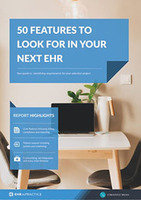Three ways to find the right oncology EHR for your practice
When you invest in an EHR, you envision it will be a critical asset to your practice’s financial health, operational efficiency and quality care delivery. You are willing to hand over your paper charts and post-it notes in exchange for technology that will help you be more efficient with your workflows while meeting ongoing reporting requirements of new value-based reimbursement models and other regulatory changes.
Unfortunately, many EHR systems on the market today still fail to meet the oncology-specific workflows and ease-of-use that community oncology practices expect and need.
Here are three things your oncology-specific EHR should do to save your practice time, money and headache when it comes to keeping up with today’s healthcare challenges:
1. Support new value-based care (VBC) initiatives
CMS is targeting that at least 50% of all Medicare payments be linked to value-based models by 2018, and Aetna aims to put 75% of their business in value-based payment arrangements by 2020.* Most oncology practices will participate in CMS’ Merit-based Incentive Payment System (MIPS); eligible clinicians who do not participate during the 2017 performance year risk incurring a negative payment adjustment in the 2019 payment period. Navigating and fulfilling the complex requirements of VBC programs like MIPS is an overwhelming task without technology that facilitates data entry, tracks quality and total cost of care, and provides seamless reporting.
Find the right oncology EHR for your practice using this free health IT comparison tool
Beyond VBC technology solutions, look for an oncology EHR partner with an experienced VBC team to help you stay on top of all of the changes associated with these evolving models so that you are best positioned for positive payment adjustment.
2. Minimize data entry by thinking like an oncologist
A good oncology EHR should facilitate efficient data entry at the point of care by aligning with the way oncologists think and pre-populating data whenever possible. Essentially, the software should offer quick referenceability for oncologists throughout the application, as well as minimize the instances they have to enter the same data for the same patient at every visit.
Additionally, it’s important that your EHR offers centralized content embedded within the application, such as a curated, continually updated library of NCCN regimen content and the latest AJCC staging standards. This saves hours of time maintaining chemotherapy libraries on your own, but still allows for regimen-specific customization in accordance with individual practice workflows.
3. Prioritize ongoing investment in product innovation and analytics
The one-size-fits-all software approach simply doesn’t work for oncology. Your oncology EHR vendor should be evolving their solution based on learnings and feedback from you and other customers, and doing so fast enough for you to keep pace with healthcare change. It’s not surprising that the most innovative EHRs are typically cloud-based because they can be more scalable and offer more immediate, no-cost upgrades than on-premise systems.
Your EHR should also come with integrated analytics tools and dashboarding that leverage data from both your EHR and practice management system to help you address your specific practice goals without spending a lot of time deciphering data and generating custom reports. Advanced analytics tools will dive deep into areas like patient population metrics, drug utilization and billing inaccuracies to provide actionable clinical and financial insights in real-time.
If you’re holding on to an EHR solution that lacks the flexibility and innovation to help you keep up with your evolving practice needs, it will continue to pose a financial and time drain on your practice.
Free white paper

50 features to look for in your next EHR
A comprehensive guide to EHR features and how they can benefit your practice

Featured white papers
Related articles
-

Top ophthalmology EHRs for your selection shortlist
Got your eye on a new ophthalmology EHR? Here are some top contenders.
-

Top oncology EHRs to kickstart your selection shortlist
Learn about some of the leading oncology EHR systems on the market including CureMD, ARIA Oncolog...
-

Five of the best EHR systems for cardiologists
Top cardiology EHR systems to kick off your selection shortlist




